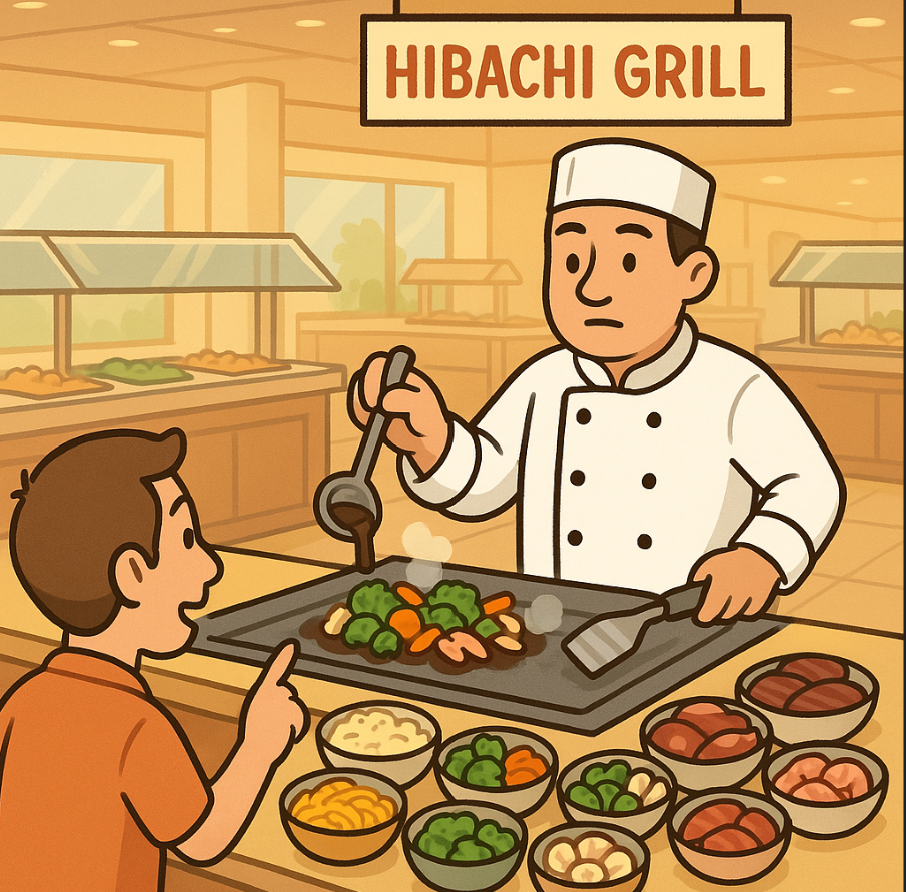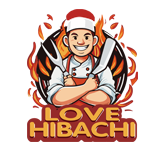Untangling the Grill: Chinese Hibachi vs. Japanese Hibachi – What's the Difference?
You've seen "Hibachi" on restaurant signs and menus, often picturing a lively chef, a flaming onion volcano, and perfectly seared morsels cooked before your eyes. This is the quintessential Japanese Hibachi Grill experience, more accurately termed "Teppanyaki." But then, you might encounter the term "Chinese Hibachi" and wonder: Are they the same? Similar? Or entirely different beasts of the culinary world?
Let's fire up the discussion and clarify the distinctions between what is commonly understood as Japanese Hibachi and the often less-defined "Chinese Hibachi."

Defining Japanese Hibachi (Teppanyaki): The Fiery Performance
When most North Americans refer to "Hibachi," they are describing Teppanyaki:
Origin: Japan. This style of cooking on a large, flat iron griddle (the "teppan") became popular post-World War II, with chains like Misono and later Benihana popularizing it globally.
The Grill: A large, flat, solid iron griddle is the centerpiece.
The Show: This is a core element! Chefs are entertainers, dazzling guests with knife skills, precise food placement, fire displays (like the onion volcano), and sometimes food-tossing antics. It’s dinner and a show.
Ingredients & Flavors: Focuses on fresh, high-quality ingredients like steak, chicken, seafood (shrimp, scallops, lobster), and various vegetables (zucchini, onions, mushrooms, bean sprouts). Seasoning is often simple yet impactful: garlic butter, soy sauce, salt, and pepper. The goal is to highlight the natural flavors of the ingredients, enhanced by the sear from the hot Japanese Teppanyaki grill.
Key Dishes: Hibachi steak, chicken, shrimp, fried rice (often prepared on the grill as part of the show), and sautéed vegetables.
Sauces: Typically served with dipping sauces on the side, most famously Yum Yum sauce (a mayonnaise-based pink/white sauce) and a ginger sauce (a savory, tangy soy-based sauce).
This style is about the freshness of ingredients, the interactive cooking performance, and relatively clean, distinct flavors.

What is "Chinese Hibachi"? The Lines Blur
This is where things get less straightforward. "Chinese Hibachi" isn't a traditional, historically defined style of Chinese cuisine in the same way Teppanyaki is for Japan. Instead, the term often emerges in a few contexts:
Chinese Buffets/Restaurants with a "Hibachi Grill" Section:
Many large Chinese buffets or multi-cuisine Asian restaurants have a station labeled "Hibachi Grill." Here, a chef (often less theatrical than a Teppanyaki chef) will cook your chosen ingredients to order on a flat-top griddle.
Ingredients & Flavors: While you might select similar raw ingredients (chicken, beef, shrimp, various vegetables, noodles, rice), the sauces and flavor profiles used are typically rooted in Chinese Cooking Styles. You're more likely to encounter sauces like teriyaki (which, while Japanese, is heavily adopted and adapted in Chinese-American cuisine), oyster sauce, hoisin sauce, Szechuan sauce, garlic sauce, sweet and sour, or other distinctly Chinese stir-fry sauces. Cornstarch is often used to thicken sauces.
The "Show": While cooked in front of you, the performative aspect is usually minimal or absent compared to Japanese Teppanyaki. The focus is more on custom stir-fry creation.
Associated Dishes: Think custom stir-fries with a choice of noodles or rice, often with a wider variety of pre-cut vegetables common in Chinese cooking (bok choy, broccoli, water chestnuts, bamboo shoots).
A Misnomer or Generalization:
Sometimes, any Asian-style grilling on a flat top might be loosely termed "hibachi" by patrons or even some establishments due to the popularity and recognizability of the term from Japanese restaurants.
Specific Restaurant Concepts:
A particular restaurant might brand itself as "Chinese Hibachi" to signify a fusion concept or a specific take on grilled Chinese dishes. However, this is more of an individual restaurant's branding than a widespread culinary category.
China has its own rich traditions of grilling, such as "chuanr" (street-style meat skewers often seasoned with cumin and chili powder) or regional BBQ styles, but these are very different from the communal flat-top grill experience of Teppanyaki.
Key Differences Summarized:
| Origin | Japan | More a concept in Chinese-American restaurants/buffets |
| Grill Type | Large, flat iron teppan | Often a flat-top griddle (can vary) |
| Performance | High – a key part of the experience | Low to none – focus on made-to-order food |
| Primary Style | Searing, grilling, minimal sauce during cooking | Stir-frying, ingredients often tossed in sauce |
| Flavor Profile | Soy sauce, garlic butter, salt, pepper; clean flavors | Diverse Chinese sauces (sweet, savory, spicy, tangy) |
| Key Sauces | Yum Yum, Ginger sauce (for dipping) | Sauces integral to the dish (e.g., General Tso's flavor if requested, various stir-fry sauces) |
| Staple Sides | Fried rice, grilled veggies cooked by the chef | Noodles, white rice; wider variety of stir-fry veggies |
Why the Confusion?
The term "hibachi" itself literally means "fire bowl" in Japanese and originally referred to a small, traditional heating device. Its North American association with Teppanyaki cooking is already a bit of a linguistic journey. Given the popularity of the Japanese Hibachi Show, it's understandable that similar open-grill cooking styles in other Asian restaurant settings might borrow the familiar "hibachi" label for marketing or ease of understanding.
Ultimately, if you're seeking the theatrical flair, the specific taste of Yum Yum sauce, and the classic Japanese Teppanyaki performance, you're looking for a Japanese Hibachi or Teppanyaki restaurant. If you see "Chinese Hibachi," especially at a buffet, anticipate a delicious, custom-made stir-fry experience with Chinese flavor profiles, cooked fresh in front of you.
No matter which you choose, the common thread is often freshly cooked food tailored to your preferences. If the classic, entertaining, and mouth-watering Japanese Hibachi Grill experience is what you crave for a special event or party right at your home, Love Hibachi brings that authentic Teppanyaki show and flavor to you. Book using this link for a $20 discount and enjoy the genuine Japanese hibachi performance!
Enjoy exploring the diverse and delicious world of Asian grilled cuisine!
aa









